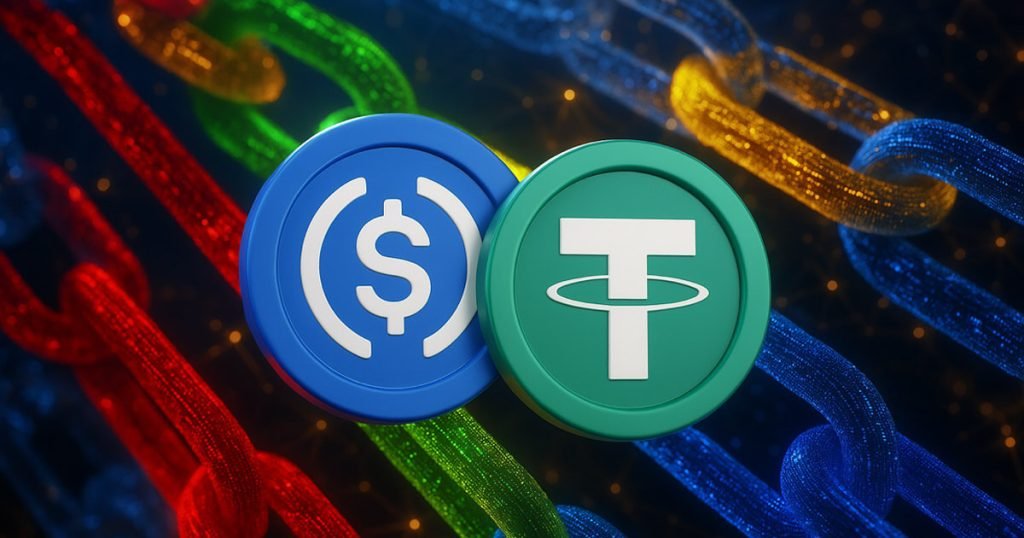Understanding the Dominance of Stablecoins in the Crypto Ecosystem
Stablecoins have emerged as a crucial pillar within the cryptocurrency landscape, forming the backbone of most crypto trading pairs and accounting for a significant portion of blockchain transactions. This article delves into the stablecoin market, especially focusing on the top five blockchain networks by stablecoin market capitalization: Ethereum, Tron, Binance Smart Chain (BSC), Base, and Arbitrum. Each of these platforms exhibits unique trends in issuance, bridging, and usage, underscoring the varying strategies and preferences of stablecoin issuers and users.
Ethereum: The Leader in Stablecoin Market Capitalization
Ethereum continues to lead the field with a staggering stablecoin market capitalization exceeding $125 billion, enjoying a steady weekly increase. This prominent status showcases Ethereum as a versatile platform for stablecoin creation and DeFi adoption. The variety of stablecoins available on Ethereum, including popular options such as Tether (USDT) and USD Coin (USDC), not only solidifies its market position but also attracts both institutional and retail investment. Around 52.21% of Ethereum’s stablecoins are represented by USDT, while USDC and other stablecoin types contribute to a diverse portfolio. This extensive mix enhances liquidity for lending protocols, liquidity pools, and various DeFi tools, reinforcing Ethereum’s significance in the crypto landscape.
Tron: A Focus on Tether with Zero Bridging
In second place, Tron boasts a stablecoin market valuation of roughly $65 billion, though its market is predominantly centered around Tether, which makes up an impressive 99.25% of the total stablecoin pool. This concentrated approach reveals Tether’s strategic intent to mint directly on the Tron network. Notably, Tron is unique in that it has reported zero bridged stablecoin value, indicating that its assets are almost entirely natively issued. This setup underscores Tron’s role as a reliable platform for swift and cost-effective stablecoin transactions, attracting users who prioritize speed and low fees over the complexities of a wider DeFi ecosystem.
Binance Smart Chain: Bridging Liquidity and Cost-Effectiveness
Ranked third, Binance Smart Chain (BSC) holds a stablecoin market cap of over $7 billion, driven primarily by Tether, though it also accommodates BUSD and USDC. A significant about $6 billion of the stablecoin supply on BSC has been bridged from other chains, highlighting users’ reliance on these bridging solutions to enhance liquidity for yield farming, trading, and other DeFi activities. Despite having less overall stablecoin liquidity compared to Ethereum or Tron, BSC’s lower transaction costs attract traders seeking a more affordable platform for their operations, marking it as an appealing option in the competitive stablecoin market.
Base: Attracting Liquidity with a Growing Ecosystem
Emerging as one of the newer contenders in the stablecoin arena, Base has already managed to accumulate over $4 billion in stablecoins, primarily spearheaded by USDC. Interestingly, around $3.9 billion of that total consists of bridged stablecoins rather than those issued natively on Base, indicating that its ecosystem has been nourished mainly by attracting liquidity from external areas, particularly Ethereum. This influx of capital is likely due to Base’s association with Coinbase and its reputation within the DeFi community for secure and reliable minting processes, encouraging users to migrate funds for more attractive yields and reduced transaction costs.
Arbitrum: Leveraging Ethereum’s Security for Growth
Arbitrum stands close to Base with a stablecoin supply of nearly $4 billion, including approximately $1.8 billion sourced from bridged liquidity. Arbitrum shares similarities with Base in its reliance on capital flowing in from Ethereum, showcasing a stablecoin composition that includes USDC and Tether. As an early Layer-2 solution, Arbitrum has succeeded in attracting several DeFi protocols that have become popular among liquidity providers seeking to replicate Ethereum’s robust infrastructure while capitalizing on lower gas fees. This dynamic showcases Arbitrum’s strength in using Ethereum’s established ecosystem to foster growth in its own market.
The Future Landscape of Stablecoins: Insights and Trends
The distinctive distributions of stablecoins across these networks highlight the prevailing market focus on Ethereum and Tron, each reflecting unique use cases. Ethereum caters to users in search of a comprehensive DeFi environment with varied stablecoin options, while Tron specializes in high-volume, cost-effective transactions dominated by Tether. This clustering around specific infrastructures underscores user strategies; they tend to migrate their resources toward frameworks that either offer extensive functionality or present lower transaction costs. Furthermore, while some chains are more reliant on bridging rather than native issuance—like BSC, Base, and Arbitrum—Tron’s total stablecoin supply is entirely native, solidifying its defined role in stablecoin transactions.
In conclusion, the continuing evolution of stablecoins will be shaped by user preferences, network functionalities, and cost considerations. As various platforms vie for dominance, the ability to attract and retain liquidity will be paramount, leading to a broader diversification of stablecoin usage across blockchain ecosystems. Understanding these trends will be crucial for participants looking to navigate the dynamic landscape of digital assets in the years to come.


